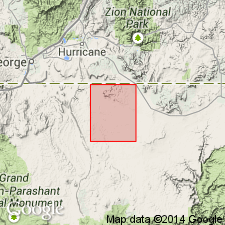
- Usage in publication:
-
- Antelope Knoll Basalt*
- Modifications:
-
- Named
- Geochronologic dating
- Mapped 1:32k (Mohave Co, AZ)
- Dominant lithology:
-
- Basalt
- AAPG geologic province:
-
- Plateau sedimentary province
Summary:
Named as a Pleistocene formation for Antelope Knoll, a pyroclastic volcanic cone 137 m high located in secs 13, 24, T38N, Rs8,9W, about 6.5 km south of map in Antelope Knoll 7.5' quad on Uinkaret Plateau, northern Mohave Co, AZ (Plateau sedimentary province). Antelope Knoll is designated as type area for unit. Mapped in southwestern part of study area where outcrop, distribution, and geomorphic position suggest that basalt followed topographic lows that can be related to ancestral stream valleys. Elongate lobe of basalt parallels modern Clayhole Wash drainage, but lies about 3 km to west; probably marks ancestral drainage of Clayhole Wash. Consists of one, fine-grained, alkali basalt flow containing sparse olivine phenocysts in groundmass of plagioclase, augite, and glass. Flow ranges from 1-4 m thick. Unit is older than Pleistocene and Holocene surficial deposits; age equivalent to Pleistocene intrusive dikes and basalt flow units; younger than Chinle Formation (Upper Triassic). Whole rock K-Ar age is 0.83 +/-0.28 ka (H. Mehnert, USGS, written commun.).
Source: GNU records (USGS DDS-6; Denver GNULEX).
For more information, please contact Nancy Stamm, Geologic Names Committee Secretary.
Asterisk (*) indicates published by U.S. Geological Survey authors.
"No current usage" (†) implies that a name has been abandoned or has fallen into disuse. Former usage and, if known, replacement name given in parentheses ( ).
Slash (/) indicates name conflicts with nomenclatural guidelines (CSN, 1933; ACSN, 1961, 1970; NACSN, 1983, 2005, 2021). May be explained within brackets ([ ]).

